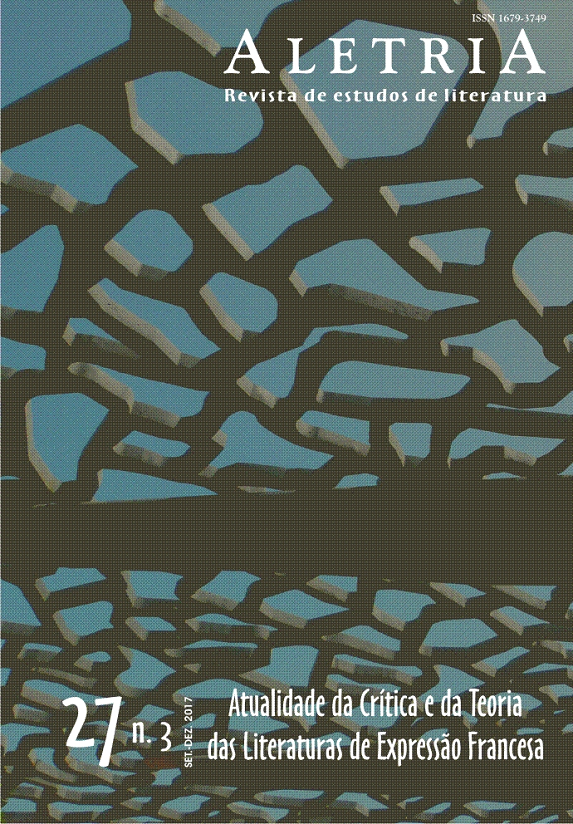Terpsichore and the Modern Novel: Ballroom Scenes in French Narratives of the 19th Century
DOI:
https://doi.org/10.17851/2317-2096.27.3.41-55Keywords:
ballroom scene, French novel, nineteenth century, modernityAbstract
This work presents a study of the French modern novel from one of its topoi: the ballroom scene, which from the 19th century on increasingly appears in a systematic way, mimicking the outbreak of the ball as a bourgeois social phenomenon, being the bourgeoisie a social class that appropriates an idealized imagery of the old ruling class, the nobility. This literary change follows the evolution of manners going on within society starting from the French Revolution – which initiated the formation of a new mentality that put in evidence the notions of the individual and of isolation. Through the reading of three ball scenes, some aspects of the tensions and conflicts that mark the individual and their relationship with the modern world are presented. As theoretical framework, studies on the novel by Watt and on the representation of reality by Auerbach are brought to the foreground.
Downloads
References
AGUIAR, Joaquim Alves de. O banquete e o prato do dia em Madame Bovary. In: FONSECA, Maria Augusta (Org.). Olhares sobre o romance. São Paulo: Nankin Editorial, 2005. p. 15-34.
AUERBACH, Erich. Mimesis: a representação da realidade na literatura ocidental. São Paulo: Perspectiva, 2015.
BALZAC, Honoré de. A comédia humana: estudos de costumes / cenas da vida privada. Orientação, introduções e notas de Paulo Rónai. Tradução de Vidal de Oliveira. 3. ed. São Paulo: Globo, 2012. v. 1.
ELIAS, Norbert. O processo civilizador: uma história dos costumes. Tradução de Ruy Jungmann. Rio de Janeiro: Jorge Zahar, 1994. v. 1.
ESQUÍVEL, Patrícia. L’Autonomie de l’art en question: l’art en tant qu’Art. Paris: L’Harmattan, 2008.
FLAUBERT, Gustave. Madame Bovary: costumes de província. Tradução, apresentação e notas de Fúlvia M. L. Moretto. São Paulo: Nova Alexandria, 2001.
HESS, Remi. La Valse: révolution du couple en Europe. Paris: A. M. Métailié, 1989.
MOAL, Philippe Le (Org). Dictionnaire de la danse. Paris: Larousse, 2008.
MONTANDON, Alain (Org.). Paris au bal: treize physiologies sur la danse. Paris: H. Champion, 2000.
STENDHAL. O vermelho e o negro. Tradução de Raquel Prado. São Paulo: Cosac Naify, 2003.
THOREL-CAILLETEAU, Sylvie. Bals romantiques. In: MONTANDON, Alain. Écrire la danse. Clermont-Ferrand: Presses Universitaires Blaise Pascal, 1999. p. 235-248.
WATT, Ian. Mitos do individualismo moderno: Fausto, Dom Quixote, Dom Juan, Robinson Crusoe. Tradução de Mario Pontes. Rio de Janeiro: Jorge Zaha, 1997.
Downloads
Published
How to Cite
Issue
Section
License
Copyright (c) 2017 Claudia Helena Daher (Autor)

This work is licensed under a Creative Commons Attribution 4.0 International License.
Authors who publish with this journal agree to the following terms:Authors retain copyright and grant the journal right of first publication with the work simultaneously licensed under a Creative Commons Attribution Non-Commercial No Derivatives License that allows others to share the work with an acknowledgement of the work's authorship and initial publication in this journal.Authors are able to enter into separate, additional contractual arrangements for the non-exclusive distribution of the journal's published version of the work (e.g., post it to an institutional repository or publish it in a book), with an acknowledgement of its initial publication in this journal.Authors are permitted and encouraged to post their work online (e.g., in institutional repositories or on their website) prior to and during the submission process, as it can lead to productive exchanges, as well as earlier and greater citation of published work (See The Effect of Open Access).





